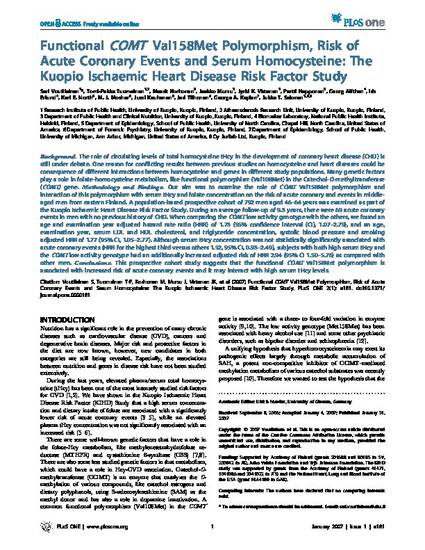
- Coronary heart disease,
- Accute coronary events,
- COMT Val158Met polymorphism
. The role of circulating levels of total homocysteine tHcy in the development of coronary heart disease (CHD) is still under debate. One reason for conflicting results between previous studies on homocysteine and heart diseases could be consequence of different interactions between homocysteine and genes in different study populations. Many genetic factors play a role in folate-homocysteine metabolism, like functional polymorphism (Val108Met) in the Catechol-O-methyltransferase (COMT) gene. Methodology and Findings. Our aim was to examine the role of COMT Val158Met polymorphism and interaction of this polymorphism with serum tHcy and folate concentration on the risk of acute coronary and events in middleaged men from eastern Finland. A population-based prospective cohort of 792 men aged 46–64 years was examined as part of the Kuopio Ischaemic Heart Disease Risk Factor Study. During an average follow-up of 9.3 years, there were 69 acute coronary events in men with no previous history of CHD. When comparing the COMT low activity genotype with the others, we found an age and examination year adjusted hazard rate ratio (HRR) of 1.73 (95% confidence interval (CI), 1.07–2.79), and an age, examination year, serum LDL and HDL cholesterol, and triglyceride concentration, systolic blood pressure and smoking adjusted HRR of 1.77 (95% CI, 1.05–2.77). Although serum tHcy concentration was not statistically significantly associated with acute coronary events (HRR for the highest third versus others 1.52, 95% CI, 0.93–2.49), subjects with both high serum tHcy and the COMT low activity genotype had an additionally increased adjusted risk of HRR 2.94 (95% CI 1.50–5.76) as compared with other men. Conclusions. This prospective cohort study suggests that the functional COMT Val158Met polymorphism is associated with increased risk of acute coronary events and it may interact with high serum tHcy levels.
